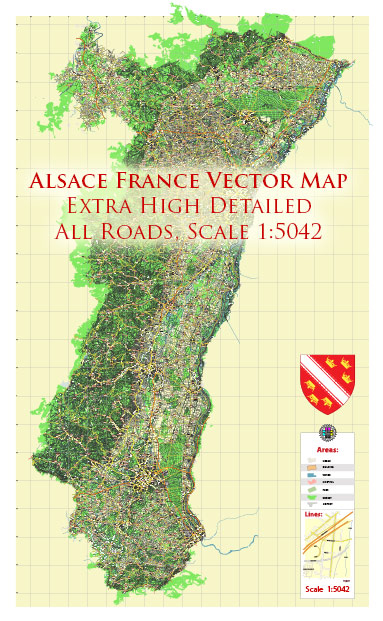A general overview of the economic and transportation aspects of Alsace, France.
Vectormap.Net provide you with the most accurate and up-to-date vector maps in Adobe Illustrator, PDF and other formats, designed for editing and printing. Please read the vector map descriptions carefully.
Economic Overview:
- Diverse Economy:
- Alsace has a diverse economy with a mix of industrial, agricultural, and service sectors.
- The region is known for its strong agricultural production, including wine, cereals, and hops.
- Industrial activities include manufacturing, particularly in the fields of chemicals, machinery, and textiles.
- Wine Industry:
- Alsace is renowned for its wine production, with vineyards covering significant portions of the region.
- The wine industry is a key contributor to the local economy, attracting tourism and export opportunities.
- Cross-Border Trade:
- Due to its location on the French-German border, Alsace has historically been involved in cross-border trade and economic cooperation.
- Tourism:
- The picturesque landscapes, charming villages, and historical sites attract tourists, contributing to the region’s economy.
- Strasbourg, the capital of Alsace, is known for its historic architecture, including the Strasbourg Cathedral and the UNESCO-listed Grande Île.
Transportation:
- Road Network:
- Alsace has a well-developed road network, facilitating the movement of goods and people.
- Major highways connect Alsace with neighboring regions and countries, such as Germany and Switzerland.
- Rail Transportation:
- The region has a comprehensive rail network, connecting major cities like Strasbourg and Mulhouse with other parts of France and Europe.
- The TGV (Train à Grande Vitesse) high-speed train service connects Strasbourg with Paris and other French cities.
- Air Transport:
- Strasbourg Airport (Entzheim Airport) serves as the primary airport in Alsace, offering domestic and international flights.
- River Transportation:
- The Rhine River forms a natural border between Alsace and Germany and serves as an important waterway for transportation.
- Public Transportation:
- Cities like Strasbourg have well-developed public transportation systems, including buses and trams, making it easy for residents and visitors to navigate urban areas.
- Cross-Border Connectivity:
- Alsace’s proximity to Germany means that it plays a crucial role in facilitating cross-border transportation and trade.
Please note that the economic and transportation landscape can evolve over time, so it’s advisable to check for the latest information from local sources or official government publications for the most up-to-date details.


 Author: Kirill Shrayber, Ph.D.
Author: Kirill Shrayber, Ph.D.